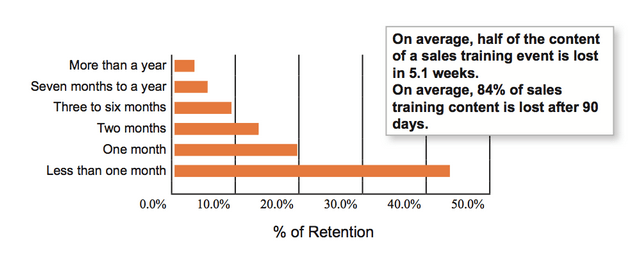Apple Watch is Only the Beginning: 5 Predictions for the Future of Sales Training
If you received your Apple Watch over the weekend, count yourself lucky—just 22% of all pre-orders, or an estimated 376,000 people, were able to get their hands on the latest Apple gadget. The Apple Watch was by no means the first smartwatch to hit the market but, in true Apple fashion, it sure felt like it was. If the buzz surrounding Apple Watch is any indication of the number of beeping wrists that we’ll see in the coming months, it will also be the first smartwatch to find real footing, potentially making a stronger case for wearable technology.
Of course, no one loves new technology quite like your sales team, so you can bet Apple Watch will start showing up on a wrist near you. So, if the Apple Watch really is a big step toward the future of wearable technology, what does that mean for sales training? How will technological advances continue to shape the way that we empower reps out in the field? In this post, we look at some rising trends and what we know about sales training to give our best estimate of what lies ahead. Here are four predictions about the future of sales training, inspired by Apple Watch.
1. There’ll be more and more devices to choose from.
Some critics have positioned the Apple Watch not as a solution to a long-standing problem, but a modern one: smartphones. The watch offers all of the same smart capabilities, without leading users down a black hole of distraction. In the same vein, we’ve seen the rise of “phablets,” or tablet-like phones, that supersede the tablet as users realize they can have less devices and more capabilities.
In the future, we predict that there will continue to be a variety of mobile devices, each with their own rise, fall, and lingering presence. It will be up sales training managers and their IT teams to accommodate these different devices in their time, and decide how and what their reps can access.
2. Reps will consume less content, more frequently.
Traditionally, sales training has revolved around “an intensive classroom experience, where the goal is to infuse as much ‘learning’ as possible into a limited time frame,” says Sales Performance International. But as of late, sales training managers have learned just how ineffective that model is, with several reports claiming that, on average, 84% of sales training content is lost after 90 days. Just like learning any nuanced skill, sales skills and business expertise take repeated practice and training in order for reps to perform with confidence and at a high level. Sales Performance International, 2011
Sales Performance International, 2011
Smartphone and tablets have been the perfect catalyst for on-the-go training, and with the continued rise of mobile devices, we predict that we’ll only see the shift to on-the-go training accelerate. Sales training managers will deliver less content to fuel field reps, but more frequently, and allow them to consume that content their own pace.
3. Content will compete with attention span.
It’s official—our attention span is now shorter than a goldfish’s. It dropped from 12 seconds in 2000 to 8 seconds in 2013, not-so-coincidentally with the rise of Facebook (2004), YouTube (2005), and Twitter (2006). Add this to to the growing amount of information that we’re exposed to each day—Forbes estimates that in 2011 it was five times as much as it was in 1986-–and it’s easy to worry that your sales training content might get lost.

For sales training content to have a shot at being read in the future, at a minimum, it needs to have impeccable UI on all devices, even if in the not-too-distant future, that device is an Apple Watch. Your reps won’t have the patience to pinch-and-zoom their way to the right information, or scroll through pages and pages of text-heavy content. Instead, the future will call for HTML5-based content that responds to every device, big and small.
4. Content will become increasingly personalized.
In the past, training managers distributed standard-issue binders for all their reps, regardless of their knowledge level or learning preference. Skimming through pages to find the information most relevant to them, or pick up where they left off, took time and caused frustration.
The future will see increasingly personalized content, allowing reps to choose how they’d like to digest the information—video, annotated pop-tips, or flashcards. Smart content will also indicate where reps last left off, and powerful search engines within the content will sift them through the information they know to the information they need, faster.
5. Data will rule.
Don’t get me wrong—salespeople already depend upon data. But, Inc. Magazine points out that this isn’t always the case for sales training: “Companies spend billions of dollars every year on sales training that attempt to ‘clone’ the winning behaviors of top salespeople, even though there’s no data to show that such training improves overall sales performance.”
In the future, training will catch up with the rest of the organization. Sales managers will look for solutions that can better predict and emulate what’s working, and what’s not. For sales training content, that means content analytics—who’s reading your content, who’s struggling with it, and what gets returned to, over and over? But overall, any solution that offers greater insight into the murky waters of learning and training will rise to the top.
The bottom line:
The arrival of the Apple Watch gives us a small glimpse into what the future could look like, and what we’ll continue to find useful, innovative, or just plain fun. That future will, of course, have an affect on sales training, and how you can give reps the kind of training that serves them, and your customers, best.
[eBook] The Secret Weapon to Sales Training
Learn how to help reps close deals faster.
